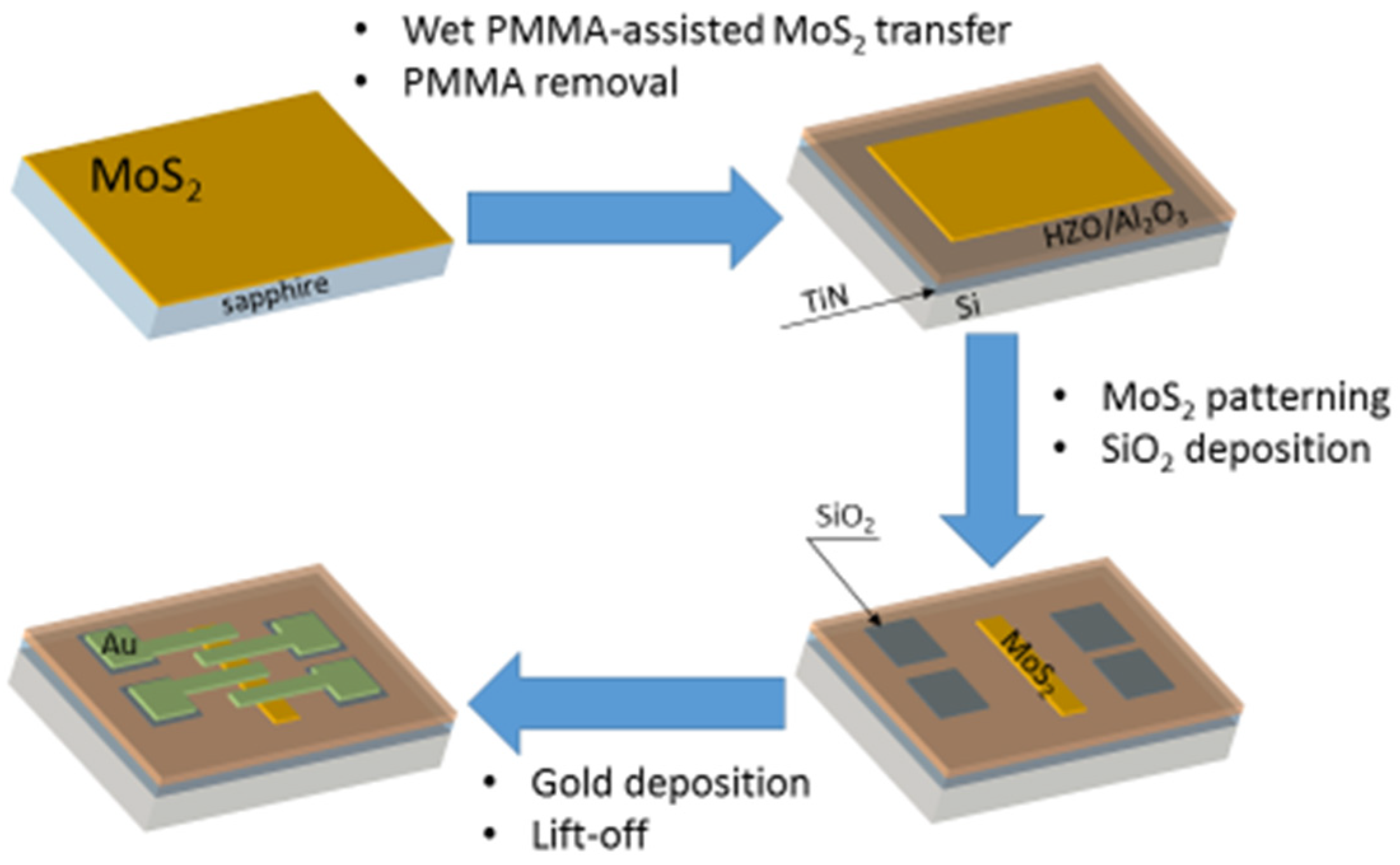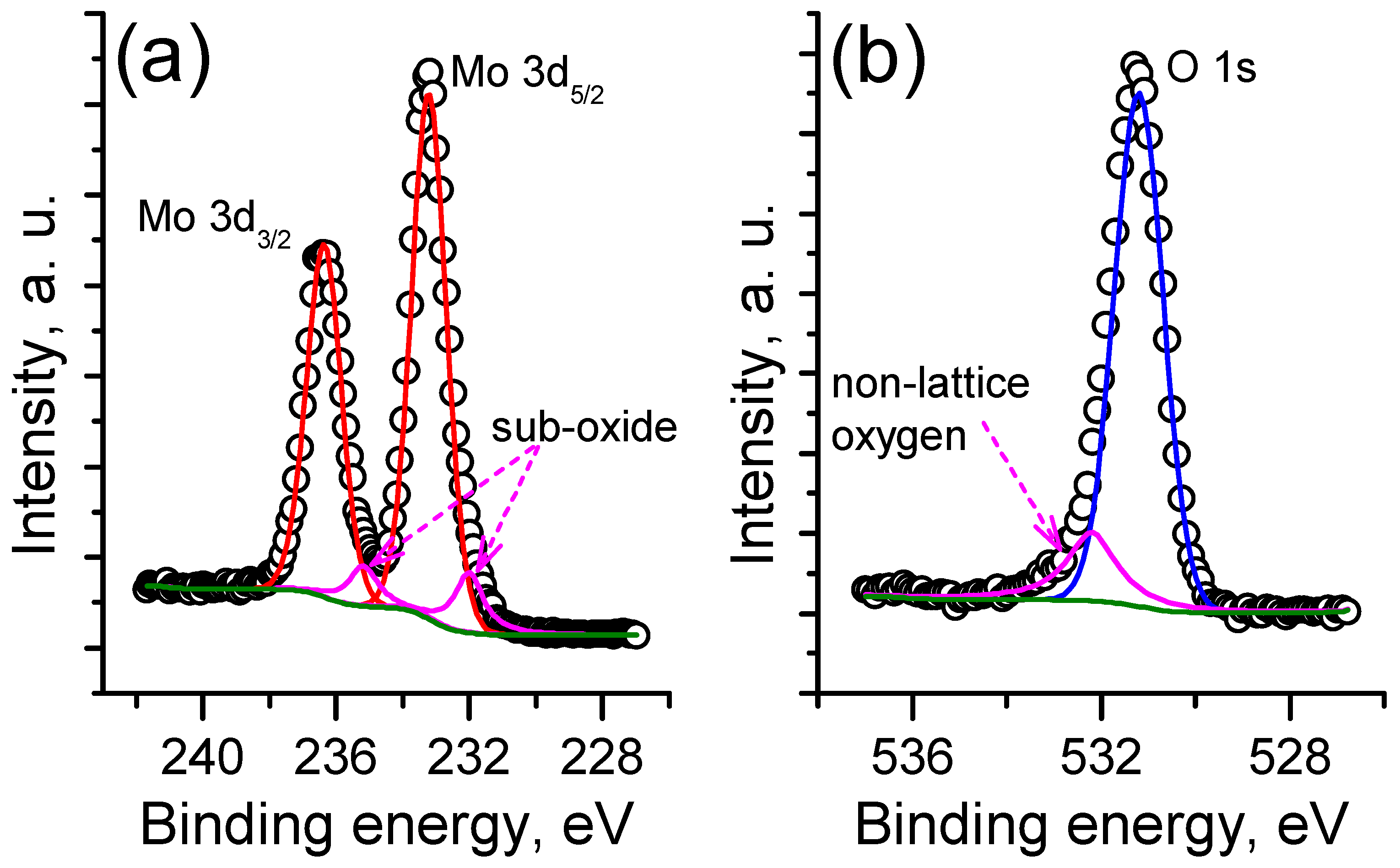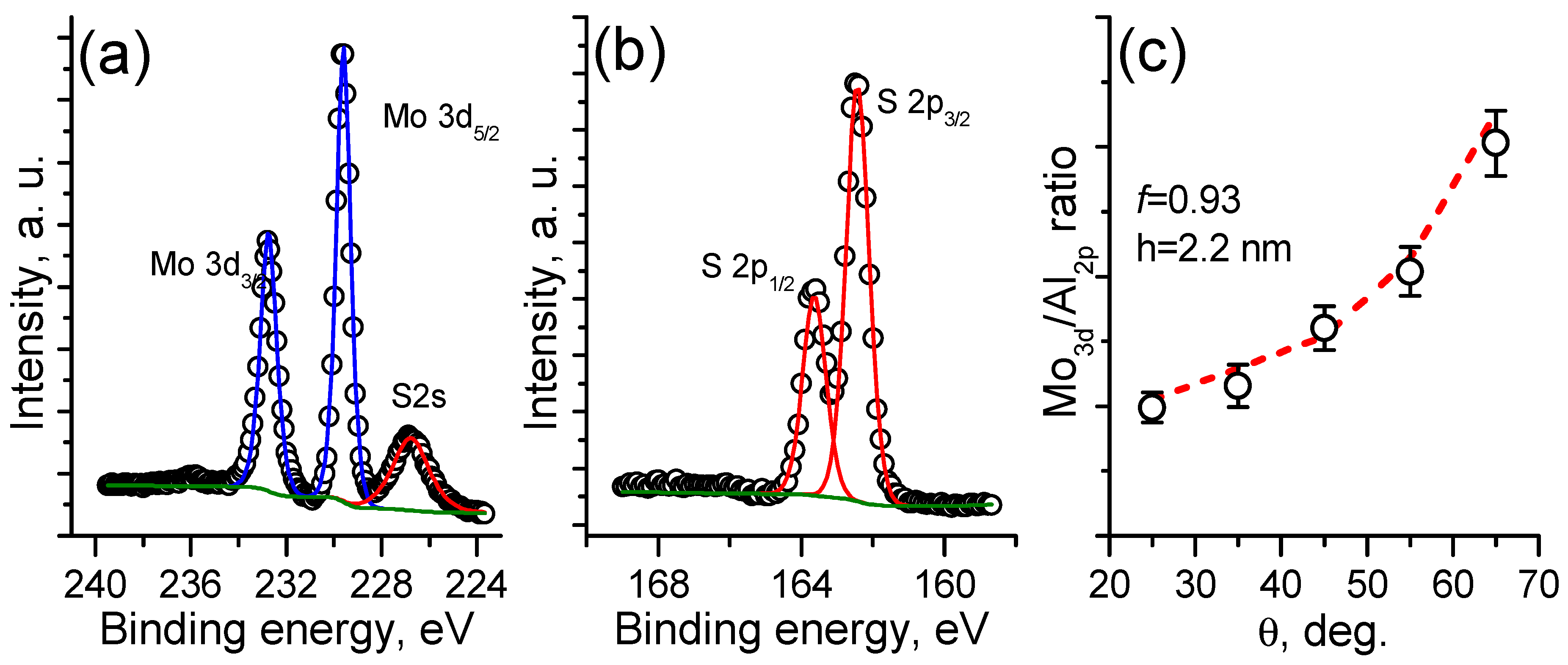Field-Effect Transistor Based on 2D Microcrystalline MoS2 Film Grown by Sulfurization of Atomically Layer Deposited MoO3
Abstract
:1. Introduction
2. Materials and Methods
2.1. MoS2 Film Preparation and Characterization
2.2. FET Preparation and Characterization
3. Results and Discussion
4. Conclusions
Author Contributions
Funding
Data Availability Statement
Acknowledgments
Conflicts of Interest
References
- Robinson, J.A. Perspective: 2D for beyond CMOS. APL Mater. 2018, 6, 058202. [Google Scholar] [CrossRef]
- Briggs, N.; Subramanian, S.; Lin, Z.; Li, X.; Zhang, X.; Zhang, K.; Xiao, K.; Geohegan, D.; Wallace, R.; Chen, L.-Q.; et al. A roadmap for electronic grade 2D materials. 2D Mater. 2019, 6, 022001. [Google Scholar] [CrossRef]
- Radisavljevic, B.; Radenovic, A.; Brivio, J.; Giacometti, V.; Kis, A. Single-layer MoS2 transistors. Nat. Nanotechnol. 2011, 6, 147–150. [Google Scholar] [CrossRef] [PubMed]
- Wang, Q.H.; Kalantar-Zadeh, K.; Kis, A.; Coleman, J.N.; Strano, M.S. Electronics and optoelectronics of two-dimensional transition metal dichalcogenides. Nat. Nanotechnol. 2012, 7, 699–712. [Google Scholar] [CrossRef]
- Voiry, D.; Yang, J.; Chhowala, M. Recent strategies for improving the catalytic activity of 2D TMD nanosheets toward the hydrogen evolution reaction. Adv. Mater. 2016, 28, 6197–6206. [Google Scholar] [CrossRef]
- Chen, X.; Liu, C.; Mao, S. Environmental analysis with 2D transition-metal-dichalcogenide-based field-effect transistors. Nano-Micro Lett. 2020, 12, 95. [Google Scholar] [CrossRef]
- Ovchinnikov, D.; Allain, A.; Huang, Y.-S.; Dumcenco, D.; Kis, A. Electrical transport properties of single-layer WS2. ACS Nano 2014, 8, 8174–8181. [Google Scholar] [CrossRef]
- Addou, R.; McDonell, S.; Barrerra, D.; Guo, Z.; Azcatl, A.; Wang, J.; Zhu, H.; Hunkle, C.L.; Quevedo-Lopez, M.; Alshareef, H.N.; et al. Impurities and Electronic Property Variations of Natural MoS2 Crystal Surfaces. ACS Nano 2015, 9, 9124–9133. [Google Scholar] [CrossRef]
- Pyeon, J.J.; Kim, S.H.; Jeong, D.S.; Baek, S.-H.; Kang, C.-Y.; Kim, J.-S.; Kim, S.K. Wafer-scale growth of MoS2 thin films by atomic layer deposition. Nanoscale 2016, 8, 10792–10798. [Google Scholar] [CrossRef]
- Jeon, W.; Cho, Y.; Jo, S.; Ahn, J.-H.; Jeong, S.-J. Wafer-Scale synthesis of reliable high-mobility molybdenum disulfide thin films via inhibitor-utilizing atomic layer deposition. Adv. Mater. 2017, 29, 1703031. [Google Scholar] [CrossRef]
- Sharma, A.; Verheijen, M.A.; Wu, L.; Karwal, S.; Vandalon, V.; Knoops, H.C.M.; Sundaram, R.S.; Hofmann, J.P.; Kessels, W.M.M.; Bol, A.A. Low-Temperature Plasma-Enhanced Atomic Layer Deposition of 2-D MoS2: Large Area, Thickness Control and Tuneable Morphology. Nanoscale 2018, 10, 8615–8627. [Google Scholar] [CrossRef] [PubMed]
- Dumcenco, D.; Ovchinnikov, D.; Marinov, K.; Lazic, P.; Gibertini, M.; Marzari, N.; Sanchez, O.L.; Kung, Y.-C.; Krasnozhon, D.; Chen, M.-W.; et al. Large-Area Epitaxial Monolayer MoS2. ACS Nano 2015, 9, 4611–4620. [Google Scholar] [CrossRef] [PubMed]
- Laskar, M.R.; Ma, L.; Kannappan, S.; Park, P.S.; Krishnamoorthy, S.; Nath, D.N.; Lu, W.; Wu, Y.; Rajan, S. Large area single crystal (0001) oriented MoS2. Appl. Phys. Lett. 2013, 102, 252108. [Google Scholar] [CrossRef]
- Chen, J.; Tang, W.; Tian, B.; Liu, B.; Zhao, X.; Liu, Y.; Ren, T.; Liu, W.; Geng, D.; Jeong, H.Y.; et al. Chemical Vapor Deposition of High-Quality Large-Sized MoS2 Crystals on Silicon Dioxide Substrates. Adv. Sci. 2016, 3, 1500033. [Google Scholar] [CrossRef]
- Kang, K.; Xie, S.; Huang, L.; Han, Y.; Huang, P.Y.; Mak, K.F.; Kim, C.-J.; Muller, D.; Park, J. High-mobility three-atom-thick semiconducting films with wafer-scale homogeneity. Nature 2015, 520, 656–660. [Google Scholar] [CrossRef]
- Lin, Y.-C.; Jariwala, B.; Bersch, B.M.; Xu, K.; Nie, Y.; Wang, B.; Eichfeld, S.M.; Zhang, X.; Choudhury, T.H.; Pan, Y.; et al. Realizing large-scale, electronic-grade two-dimensional semiconductors. ACS Nano 2018, 12, 965–975. [Google Scholar] [CrossRef]
- Lee, D.H.; Sim, Y.; Wang, J.; Kwon, S.-Y. Metal-organic chemical vapor deposition of 2D van der Waals materials-The challenges and the extensive future opportunities. APL Mater. 2020, 8, 030901. [Google Scholar] [CrossRef]
- Groven, B.; Mehta, A.N.; Bender, H.; Meersschaut, J.; Nuytten, T.; Verdonck, P.; Conard, T.; Smets, Q.; Schram, T.; Schoenaers, B.; et al. Two-Dimensional Crystal Grain Size Tuning in WS2 Atomic Layer Deposition: An Insight in the Nucleation Mechanism. Chem. Mater. 2018, 30, 7648–7663. [Google Scholar] [CrossRef]
- Balasubramanyam, S.; Shirazi, M.; Bloodgood, M.A.; Wu, L.; Verheijen, M.A.; Vandalon, V.; Kessels, W.M.M.; Hofmann, J.P.; Bol, A.A. Edge-site nanoengineering of WS2 by low-temperature plasma-enhanced atomic layer deposition for electrocatalytic hydrogen evolution. Chem. Mater. 2019, 31, 5104–5115. [Google Scholar] [CrossRef]
- Kim, T.; Mun, J.; Park, H.; Joung, D.; Diware, M.; Won, C.; Park, J.; Jeong, S.-H.; Kang, S.-W. Wafer-scale Production of Highly-Uniform Two-Dimensional MoS2 by Metal-Organic Chemical Vapor Deposition. Nanotechnology 2017, 28, 18LT01. [Google Scholar] [CrossRef]
- Kwak, T.; Lee, J.; So, B.; Choi, U.; Nam, O. Growth Behavior of Wafer-Scale Two-Dimensional MoS2 Layer Growth Using Metal-Organic Chemical Vapor Deposition. J. Cryst. Growth 2019, 510, 50–55. [Google Scholar] [CrossRef]
- Zhang, K.; Bersch, B.M.; Zhang, F.; Briggs, N.C.; Subramanian, S.; Xu, K.; Chubarov, M.; Wang, K.; Lerach, J.O.; Redwing, J.M.; et al. Considerations for Utilizing Sodium Chloride in Epitaxial Molybdenum Disulfide. ACS Appl. Mater. Interfaces 2018, 10, 40831–40837. [Google Scholar] [CrossRef] [PubMed]
- Kim, H.; Ovchinnikov, D.; Deiana, D.; Unuchek, D.; Kis, A. Suppressing Nucleation on Metal-Organic Chemical Vapor Deposition of MoS2 Monolayers by Alkali Metal Halides. Nano Lett. 2017, 17, 5056–5063. [Google Scholar] [CrossRef] [PubMed]
- Lin, Y.-C.; Zhang, W.; Huang, J.-K.; Liu, K.-K.; Lee, Y.-H.; Liang, C.-T.; Chu, C.-W.; Li, L.-J. Wafer-scale MoS2 thin layers prepared by MoO3 sulfurization. Nanoscale 2012, 4, 6637–6641. [Google Scholar] [CrossRef]
- Martella, C.; Melloni, P.; Cinquanta, E.; Cianci, E.; Alia, M.; Longo, M.; Lamperti, A.; Vangelista, S.; Fancuilli, M.; Molle, A. Engineering the Growth of MoS2 via Atomic Layer Deposition of Molybdenum Oxide Film Precursor. Adv. Electron. Mater. 2016, 2, 1600330. [Google Scholar] [CrossRef]
- Heyne, M.H.; Chiappe, D.; Meersschaut, J.; Nuytten, T.; Conard, T.; Bender, H.; Huyghbaert, C.; Radu, I.P.; Caymax, M.; de Marneffe, J.-F.; et al. Multilayer MoS2 growth by metal and metal oxide sulfurization. J. Mater. Chem. C 2016, 4, 1295–1304. [Google Scholar] [CrossRef]
- Vangelista, S.; Cinquanta, E.; Martella, C.; Alia, M.; Longo, M.; Lamperti, A.; Mantovan, R.; Basset, F.B.; Pezzoli, F.; Molle, A. Towards a uniform and large-scale deposition of MoS2 nanosheets via sulfurization of ultra-thin Mo-based solid films. Nanotechnology 2016, 27, 175703. [Google Scholar] [CrossRef]
- Romanov, R.I.; Kozodaev, M.G.; Myakota, D.I.; Chernikova, A.G.; Novikov, S.M.; Volkov, V.S.; Slavich, A.S.; Zarubin, S.S.; Chizhov, P.S.; Khakimov, R.R.; et al. Synthesis of Large Area Two-Dimensional MoS2 Films by Sulfurization of Atomic Layer Deposited MoO3 Thin Film for Nanoelectronic Applications. ACS Appl. Nano Mater. 2019, 2, 7521–7531. [Google Scholar] [CrossRef]
- Mackus, A.J.M.; Schneider, J.R.; MacIsaac, C.; Baker, J.G.; Bent, S.F. Synthesis of Doped, Ternary, and Quaternary Materials by Atomic Layer Deposition: A Review. Chem. Mater. 2019, 31, 1142–1183. [Google Scholar] [CrossRef]
- Knoops, H.C.M.; Faraz, T.; Arts, K.; Kessels, W.M.M. Status and Prospects of Plasma-Assisted Atomic Layer Deposition. J. Vac. Sci. Technol. A 2019, 37, 030902. [Google Scholar] [CrossRef] [Green Version]
- Kozodaev, M.G.; Romanov, R.I.; Chernikova, A.G.; Markeev, A.M. Atomic Layer Deposition of Ultrathin Tungsten Oxide Films from WH2(Cp)2 and Ozone. J. Phys. Chem. C 2021, 125, 21663–21669. [Google Scholar] [CrossRef]
- Lee, B.H.; Byunghoon, Y.; Abdulagatov, A.I.; Hall, R.A.; George, S.M. Growth and Properties of Hybrid Organic-Inorganic Metalcone Films using Molecular Layer Deposition Techniques. Adv. Funct. Mater. 2013, 23, 532–546. [Google Scholar] [CrossRef]
- Alekhin, A.P.; Chouprik, A.A.; Gudkova, S.A.; Markeev, A.M.; Lebedinskii, Y.Y.; Matveyev, Y.A.; Zenkevich, A.V. Structural and electrical properties of TixAl1-xOy thin films grown by atomic layer deposition. J. Vac. Sci. Technol. B 2011, 29, 01A302. [Google Scholar] [CrossRef]
- Kozodaev, M.G.; Chernikova, A.G.; Korostylev, E.V.; Park, M.H.; Khakimov, R.R.; Hwang, C.S.; Markeev, A.M. Mitigating wakeup effect and improving endurance of ferroelectric HfO2-ZrO2 thin films by careful La-doping. J. Appl. Phys. 2019, 125, 034101. [Google Scholar] [CrossRef]
- Zhang, H.; Arutchelvan, G.; Meerschaut, J.; Gaur, A.; Conard, T.; Bender, H.; Lin, D.; Asselberghs, I.; Heyns, M.; Radu, I.; et al. MoS2 Functionalization with a Sub-nm Thin SiO2 Layer for Atomic Layer Deposition of High-k Dielectrics. Chem. Mater. 2017, 29, 6772–6780. [Google Scholar] [CrossRef]
- Mahlouji, R.; Verheijen, M.A.; Zhang, Y.; Hofmann, J.P.; Kessels, W.M.M.; Bol, A.A. Thickness and Morphology Dependent Electrical Properties of ALD-Synthesized MoS2 FETs. Adv. Electron. Mater. 2022, 8, 2100781. [Google Scholar] [CrossRef]
- Lu, Y.; Chen, T.; Ryu, G.-H.; Huang, H.; Sheng, Y.; Chang, R.-J.; Warner, J.H. Self-Limiting Growth of High-Quality 2D Monolayer MoS2 by Direct Sulfurization Using Precursor-Soluble Substrates for Advanced Field-Effect Transistors and Photodetectors. ACS Appl. Nano Mater. 2019, 2, 369–378. [Google Scholar] [CrossRef]
- Liu, Y.; Gu, F. A Wafer-Scale Synthesis of Monolayer MoS2 and their field-effect transistors toward practical applications. Nanoscale Adv. 2021, 3, 2117–2138. [Google Scholar] [CrossRef]
- Romanov, R.I.; Kozodaev, M.G.; Chernikova, A.G.; Zabrosaev, I.V.; Chouprik, A.A.; Zarubin, S.S.; Novikov, S.M.; Volkov, V.S.; Markeev, A.M. Thickness-Dependent Structural and Electrical Properties of WS2 Nanosheets Obtained via the ALD-Grown WO3 Sulfurization Technique as a Channel Material for Field-Effect Transistors. ACS Omega 2021, 6, 34429–34437. [Google Scholar] [CrossRef]
- Schram, T.; Smets, Q.; Groven, B.; Heyne, M.H.; Kunnen, E.; Thiam, A.; Devriendt, K.; Delabie, A.; Lin, D.; Lux, M.; et al. WS2 transistors on 300 mm wafers with BEOL compatibility. In Proceedings of the IEEE 47th European Solid-State Device Research Conference, Leuven, Belgium, 11–14 September 2017. [Google Scholar]
- Shimizu, J.; Ohashi, T.; Matsuura, K.; Muneta, I.; Kakushima, K.; Tsutsui, K.; Ikarashi, N.; Wakabayashi, H. Low-carrier Density sputtered-MoS2 Film by H2S annealing for Normally-Off Accumulation-mode FET. In Proceedings of the IEEE Electron Devices Technology and Manufacturing Conference (EDTM), Toyama, Japan, 28 February–2 March 2017. [Google Scholar]
- Toyama, M.; Ohashi, T.; Matsuura, K.; Shimizu, J.; Muneta, I.; Kakushima, K.; Tsutsui, K.; Wakabayashi, H. Ohmic Contact between Titanium and Sputtered MoS2 Films Achieved by Forming-Gas Annealing. Jpn. J. Appl. Phys. 2018, 57, 07MA04. [Google Scholar] [CrossRef]
- Matsuura, K.; Hamada, M.; Hamada, T.; Tanigawa, H.; Sakamoto, T.; Cao, W.; Parto, C.; Hori, A.; Muneta, I.; Kawanago, T.; et al. Normally-Off Sputtered-MoS2 nMISFETs with MoSi2 Contact by Sulfur Powder Annealing and ALD Al2O3 Gate Dielectric for Chip Level Integration. In Proceedings of the IEEE International Workshop on Junction Technology, Kyoto, Japan, 6–7 June 2019. [Google Scholar]
- Matsuura, K.; Hamada, M.; Hamada, T.; Tanigawa, H.; Sakamoto, T.; Hori, A.; Muneta, I.; Kawanago, T.; Kakushima, K.; Tsutsui, K.; et al. Normally-Off Sputtered-MoS2 nMISFETs with TiN top-gate electrode all defined by optical lithography for chip-level integration. Jpn. J. Appl. Phys. 2020, 59, 080906. [Google Scholar] [CrossRef]
- Kozodaev, M.G.; Slavich, A.S.; Romanov, R.I.; Zarubin, S.S.; Markeev, A.M. Influence of Reducing Agent on Properties of Thin WS2 Nanosheets Prepared by Sulfurization of Atomic Layer Deposited WO3. J. Phys. Chem. C 2020, 124, 28169–28177. [Google Scholar] [CrossRef]
- Mahlouji, R.; Zhang, Y.; Verheijen, M.A.; Hofmann, J.P.; Kessels, W.M.M.; Sagade, A.A.; Bol, A.A. On the Contact Optimization of ALD-Based MoS2 FETs: Correlation of Processing Conditions and Interface Chemistry with Device Electrical Performance. ACS Appl. Electron. Mater. 2021, 3, 3185–3199. [Google Scholar] [CrossRef] [PubMed]
- Vos, M.F.J.; Macco, B.; Thiessen, N.F.W.; Bol, A.A.; Kessels, W.M.M. Atomic layer deposition of molybdenum oxide from (NtBu)2(NMe2)2Mo and O2 plasma. J. Vac. Sci. Technol. A 2016, 34, 01A103. [Google Scholar] [CrossRef]
- Romanov, R.I.; Kozodaev, M.G.; Lebedinskii, Y.Y.; Perevalov, T.V.; Slavich, A.S.; Hwang, C.S.; Markeev, A.M. Radical-Enhanced Atomic Layer Deposition of a Tungsten Oxide Film with the Tunable Oxygen Vacancy Concentration. J. Phys. Chem. C 2020, 124, 18156–18164. [Google Scholar] [CrossRef]
- Chakraborty, B.; Matte, H.S.S.R.; Sood, A.K.; Rao, C.N.R. Layer-Dependent Resonant Raman Scattering of a Few Layer MoS2. J. Raman Spectrosc. 2013, 44, 92–96. [Google Scholar] [CrossRef]
- Mignuzzi, S.; Pollard, A.J.; Bonini, N.; Brennan, B.; Gilmore, I.S.; Pimenta, M.A.; Richards, D.; Roy, D. Effect of disorder on Raman scattering of single-layer MoS2. Phys. Rev. B 2015, 91, 195411. [Google Scholar] [CrossRef]
- Li, J.; Su, W.; Chen, F.; Fu, L.; Ding, S.; Song, K.; Huang, X.; Zhang, L. Atypical Defect-Mediated Photoluminescence and Resonance Raman Spectroscopy of Monolayer WS2. J. Phys. Chem. C 2019, 123, 3900–3907. [Google Scholar] [CrossRef]
- Blanco, E.; Afanasiev, P.; Berhault, G.; Uzio, D.; Loridant, S. Resonance Raman spectroscopy as a probe of the crystallite size of MoS2 nanoparticles. Comptes Rendus Chim. 2016, 19, 1310–1314. [Google Scholar] [CrossRef]
- Van der Zande, A.M.; Huang, P.Y.; Chenet, D.A.; Berkelbach, T.C.; You, Y.; Lee, G.-H.; Heinz, T.F.; Reichman, D.R.; Muller, D.A.; Hone, J.C. Grains and Grain Boundaries in Highly Crystalline Monolayer Molybdenum Disulphide. Nat. Mater. 2013, 12, 554–561. [Google Scholar] [CrossRef] [PubMed] [Green Version]
- Najmaei, S.; Amani, M.; Chin, M.L.; Liu, Z.; Birdwell, A.G.; O’Regan, T.P.; Ajayan, P.M.; Dubey, M.; Lou, J. Electrical Transport Properties of Polycrystalline Monolayer Molybdenum Disulfide. ACS Nano 2014, 8, 7930–7937. [Google Scholar] [CrossRef]
- Yoon, Y.; Ganapathi, K.; Salahuddin, S. How Good Can Monolayer MoS2 transistors Be? Nano Lett. 2011, 11, 3768–3773. [Google Scholar] [CrossRef]
- Si, M.; Su, C.-J.; Jiang, C.; Conrad, N.J.; Zhou, H.; Maize, K.D.; Qiu, G.; Wu, C.-T.; Shakouri, A.; Alam, M.A.; et al. Steep-Slope Hysteresis-Free Negative Capacitance MoS2 Transistors. Nat. Nanotechnol. 2018, 13, 24–28. [Google Scholar] [CrossRef]
- Giubileo, F.; Di Bartolomeo, A. The Role of Contact resistance in Graphene Field-Effect Devices. Prog. Surf. Sci. 2017, 92, 143–175. [Google Scholar] [CrossRef]
- Ni, J.; Fu, Q.; Ostrikov, K.; Gu, X.; Nan, H.; Xiao, S. Status and Prospects of Ohmic Contacts on Two-Dimensional Semiconductors. Nanotechnology 2022, 33, 062005. [Google Scholar] [CrossRef]
- Jahangir, I.; Uddin, M.A.; Singh, A.K.; Koley, G.; Chandrashekhar, M.V.S. Richardson Constant and Electrostatics in Transfer-Free CVD-grown Few-Layer MoS2/Graphene Barristor with Schottky barrier Modulation >0.6eV. Appl. Phys. Lett. 2017, 111, 142101. [Google Scholar] [CrossRef]
- Kaushik, N.; Nipane, A.; Basheer, F.; Dubey, S.; Grover, S.; Deshmukh, M.M.; Lodha, S. Schottky Barrier Heights for Au and Pd contacts to MoS2. Appl. Phys. Lett. 2014, 105, 113505. [Google Scholar] [CrossRef]







| Parameter | Sulfurized MoS2-Based FET | Flake-Based FET |
|---|---|---|
| Ion/Ioff | 40 | 5 × 104 |
| SS, mV/dec | 2900 | 320 |
| µ, cm2/V·s | 4 × 10−6 | 0.4 cm2/V·s |
| Ion, A/µm | 8 × 10−11 | 8 × 10−6 |
Publisher’s Note: MDPI stays neutral with regard to jurisdictional claims in published maps and institutional affiliations. |
© 2022 by the authors. Licensee MDPI, Basel, Switzerland. This article is an open access article distributed under the terms and conditions of the Creative Commons Attribution (CC BY) license (https://creativecommons.org/licenses/by/4.0/).
Share and Cite
Zabrosaev, I.V.; Kozodaev, M.G.; Romanov, R.I.; Chernikova, A.G.; Mishra, P.; Doroshina, N.V.; Arsenin, A.V.; Volkov, V.S.; Koroleva, A.A.; Markeev, A.M. Field-Effect Transistor Based on 2D Microcrystalline MoS2 Film Grown by Sulfurization of Atomically Layer Deposited MoO3. Nanomaterials 2022, 12, 3262. https://doi.org/10.3390/nano12193262
Zabrosaev IV, Kozodaev MG, Romanov RI, Chernikova AG, Mishra P, Doroshina NV, Arsenin AV, Volkov VS, Koroleva AA, Markeev AM. Field-Effect Transistor Based on 2D Microcrystalline MoS2 Film Grown by Sulfurization of Atomically Layer Deposited MoO3. Nanomaterials. 2022; 12(19):3262. https://doi.org/10.3390/nano12193262
Chicago/Turabian StyleZabrosaev, Ivan V., Maxim G. Kozodaev, Roman I. Romanov, Anna G. Chernikova, Prabhash Mishra, Natalia V. Doroshina, Aleksey V. Arsenin, Valentyn S. Volkov, Alexandra A. Koroleva, and Andrey M. Markeev. 2022. "Field-Effect Transistor Based on 2D Microcrystalline MoS2 Film Grown by Sulfurization of Atomically Layer Deposited MoO3" Nanomaterials 12, no. 19: 3262. https://doi.org/10.3390/nano12193262





